#the three youngest daughters of George iii
Text

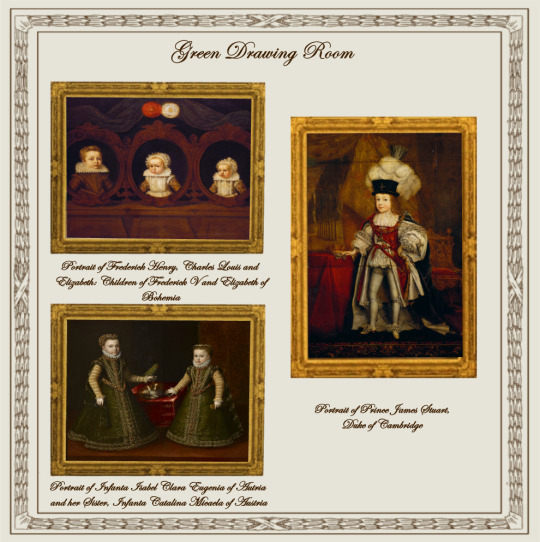
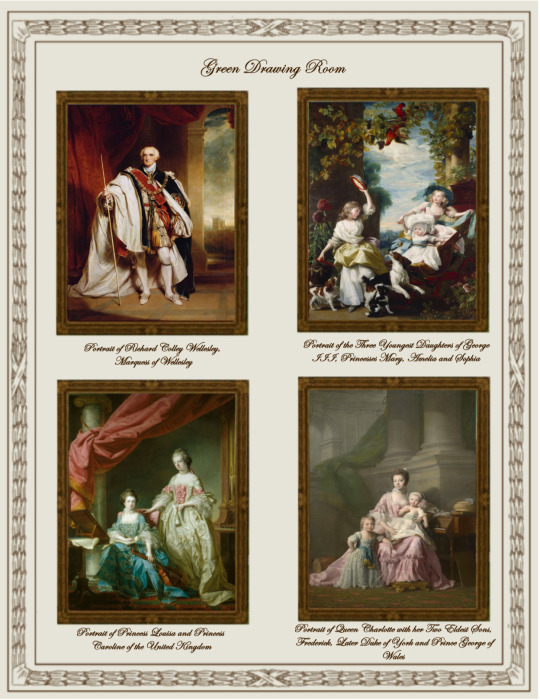
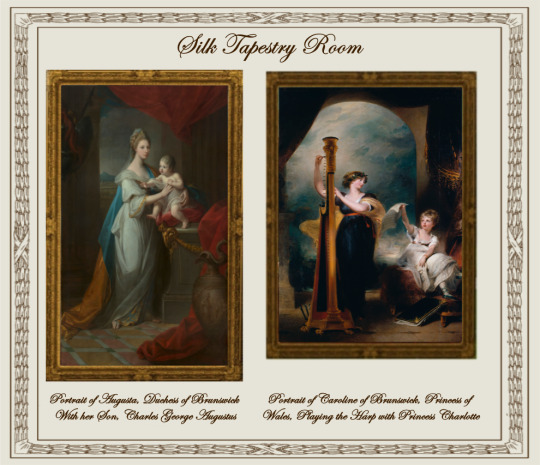
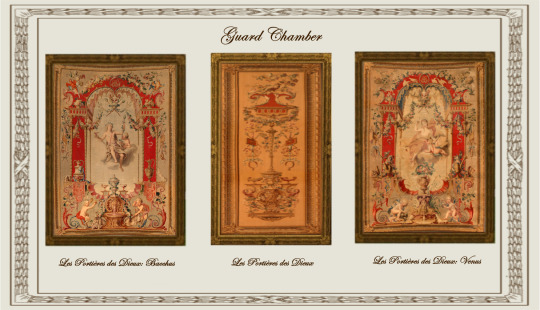

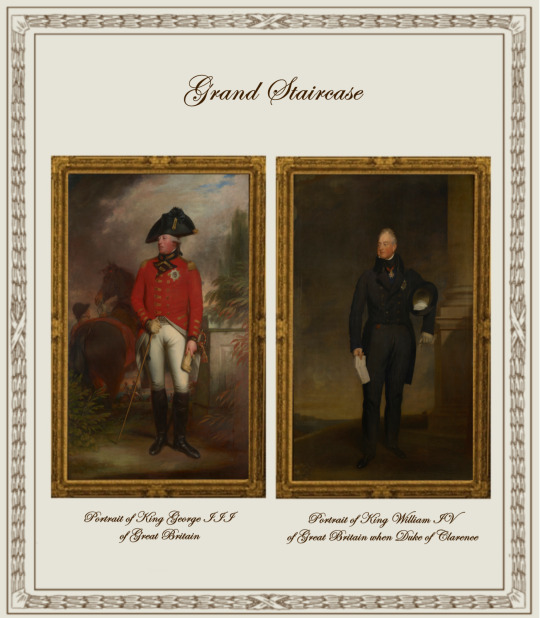
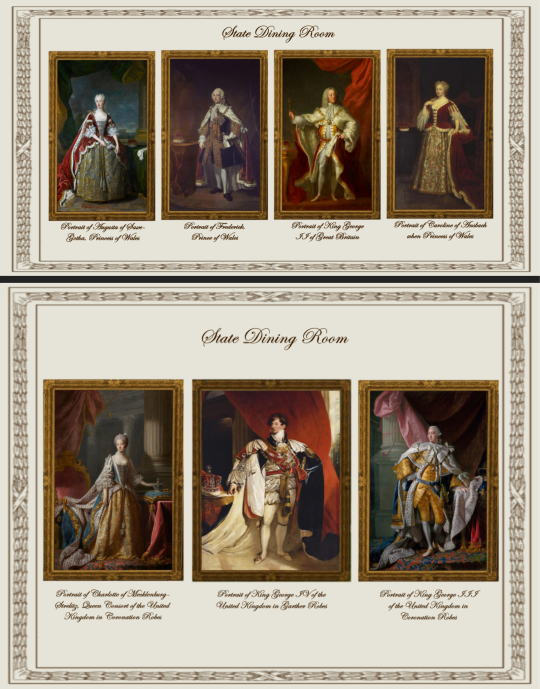
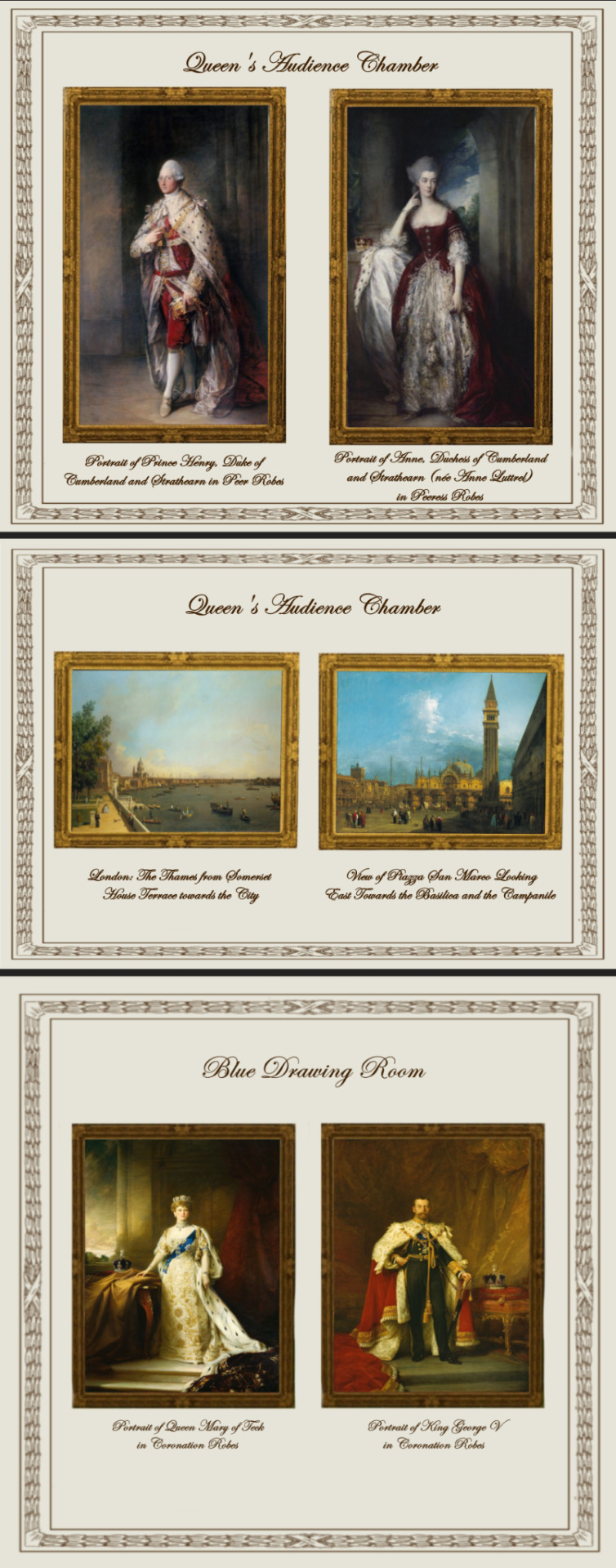
Paintings from Buckingham Palace: part I
A retexture by La Comtesse Zouboff — Original Mesh by @thejim07
100 followers gift!
First of all, I would like to thank you all for this amazing year! It's been a pleasure meeting you all and I'm beyond thankful for your support.
Spread among 13 occupied and historic royal residences in the United Kingdom, the collection is owned by King Charles III and overseen by the Royal Collection Trust. The British monarch owns some of the collection in right of the Crown and some as a private individual. It is made up of over one million objects, including 7,000 paintings, over 150,000 works on paper, this including 30,000 watercolours and drawings, and about 450,000 photographs, as well as around 700,000 works of art, including tapestries, furniture, ceramics, textiles, carriages, weapons, armour, jewellery, clocks, musical instruments, tableware, plants, manuscripts, books, and sculptures.
Some of the buildings which house the collection, such as Hampton Court Palace, are open to the public and not lived in by the Royal Family, whilst others, such as Windsor Castle, Kensington Palace and the most remarkable of them, Buckingham Palace are both residences and open to the public.
About 3,000 objects are on loan to museums throughout the world, and many others are lent on a temporary basis to exhibitions.
-------------------------------------------------------
This first part includes the paintings displayed in the White Drawing Room, the Green Drawing Room, the Silk Tapestry Room, the Guard Chamber, the Grand Staircase, the State Dining Room, the Queen's Audience Room and the Blue Drawing Room,
This set contains 37 paintings and tapestries with the original frame swatches, fully recolourable. They are:
White Drawing Room (WDR):
Portrait of François Salignan de la Mothe-Fénelon, Archbishop of Cambrai (Joseph Vivien)
Portrait of a Lady (Sir Peter Lely)
Portrait of a Man in Armour with a red scarf (Anthony van Dyck)
Portrait of Alexandra of Denmark, Queen Consort of the United Kingdom and Empress of India (François Flameng)
Green Drawing Room (GDR):
Portrait of Prince James Stuart, Duke of Cambridge (John Michael Wright)
Portrait of Frederick Henry, Charles Louis and Elizabeth: Children of Frederick V and Elizabeth of Bohemia (unknown)
Portrait of Infanta Isabel Clara Eugenia of Autria and her Sister, Infanta Catalina Micaela of Austria (Alonso Sanchez Coello)
Portrait of Princess Louisa and Princess Caroline of the United Kingdom (Francis Cotes)
Portrait of Queen Charlotte with her Two Eldest Sons, Frederick, Later Duke of York and Prince George of Wales (Allan Ramsay)
Portrait of Richard Colley Wellesley, Marquess of Wellesley (Martin Archer Shee)
Portrait of the Three Youngest Daughters of George III, Princesses Mary, Amelia and Sophia (John Singleton Copley)
Silk Tapestry Room (STR):
Portrait of Caroline of Brunswick, Princess of Wales, Playing the Harp with Princess Charlotte (Sir Thomas Lawrence)
Portrait of Augusta, Duchess of Brunswick With her Son, Charles George Augustus (Angelica Kauffmann)
Guard Chamber (GC):
Les Portières des Dieux: Bacchus (Manufacture Royale des Gobelins)
Les Portières des Dieux: Venus (Manufacture Royale des Gobelins)
Les Portières des Dieux (Manufacture Royale des Gobelins)
Grand Staircarse (GS):
Portrait of Adelaide of Saxe-Meiningen, Queen Consort of Great Britain (Martin Archer Shee)
Portrait of Augustus, Duke of Sussex (Sir David Wilkie)
Portrait of Edward, Duke of Kent (George Dawe)
Portrait of King George III of Great Britain (Sir William Beechey)
Portrait of King William IV of Great Britain when Duke of Clarence (Sir Thomas Lawrence)
Portrait of Leopold I, King of the Belgians (William Corden the Younger)
Portrait of Prince George of Cumberland, Later King George V of Hanover When a Boy (Sir Thomas Lawrence)
Portrait of Princess Charlotte Augusta of Wales (George Dawe)
Portrait of Queen Charlotte at Frogmore House (Sir William Beechey)
Portrait of Victoria of Saxe-Coburg-Saafeld, Duchess of Kent (Sir George Hayter)
State Dining Room (SDR):
Portrait of Charlotte of Mecklenburg-Strelitz, Queen Consort of the United Kingdom in Coronation Robes (Allan Ramsay)
Portrait of King George III of the United Kingdom in Coronation Robes (Allan Ramsay)
Portrait of Augusta of Saxe-Gotha, Princess of Wales (Jean-Baptiste Van Loo)
Portrait of Caroline of Ansbach when Princess of Wales (Sir Godfrey Kneller)
Portrait of Frederick, Princes of Wales (Jean-Baptiste Van Loo)
Portrait of King George II of Great Britain (John Shackleton)
Portrait of King George IV of the United Kingdom in Garther Robes (Sir Thomas Lawrence)
Queen's Audience Room (QAR):
Portrait of Anne, Duchess of Cumberland and Strathearn (née Anne Luttrel) in Peeress Robes (Sir Thomas Gainsborough)
Portrait of Prince Henry, Duke of Cumberland and Strathearn in Peer Robes (Sir Thomas Gainsborough)
London: The Thames from Somerset House Terrace towards the City (Giovanni Antonio Canal "Canaletto")
View of Piazza San Marco Looking East Towards the Basilica and the Campanile (Giovanni Antonio Canal "Canaletto")
Blue Drawing Room (BDR)
Portrait of King George V in Coronation Robes (Sir Samuel Luke Fildes)
Portrait of Queen Mary of Teck in Coronation Robes (Sir William Samuel Henry Llewellyn)
-------------------------------------------------------
Found under decor > paintings for:
500§ (WDR: 1,2 & 3)
1850§ (GDR: 1)
1960§ (GDR: 2 & 3 |QAR 3 & 4)
3040§ (STR, 1 |GC: 1 & 2|SDR: 1 & 2)
3050§ (GC:1 |GS: all 10|WDR: 4 |SDR: 3,4,5 & 6)
3560§ (QAR: 1 & 2|STR: 2)
3900§ (SDR: 7| BDR: 1 & 2|GDR: 4,5,6 & 7)
Retextured from:
"Saint Mary Magdalene" (WDR: 1,2 & 3) found here .
"The virgin of the Rosary" (GDR: 1) found here .
"The Four Cardinal Virtues" (GDR: 2&3|QAR 3 & 4) found here.
"Mariana of Austria in Prayer" (STR, 1, GC: 1 & 2|SDR: 1 & 2) found here.
"Portrait of Philip IV with a lion at his feet" (GC:1 |GS: all 10|WDR: 4 |SDR: 3,4,5 & 6) found here
"Length Portrait of Mrs.D" (QAR: 1 & 2|STR: 2) found here
"Portrait of Maria Theresa of Austria and her Son, le Grand Dauphin" (SDR: 7| BDR: 1 & 2|GDR: 4,5,6 & 7) found here
(you can just search for "Buckingham Palace" using the catalog search mod to find the entire set much easier!)

Drive
(Sims3pack | Package)
(Useful tags below)
@joojconverts @ts3history @ts3historicalccfinds @deniisu-sims @katsujiiccfinds @gifappels-stuff
-------------------------------------------------------
#the sims 3#ts3#s3cc#sims 3#sims 3 cc#sims 3 download#sims 3 decor#edwardian#rococo#baroque#renaissance#buckingham#buckingham palace#royal collection trust#wall decor
95 notes
·
View notes
Text

Emperor Nicholas I (1796 - 1855) and Empress Alexandra Feodorovna (1798 -1860 - nee Princess Friederike Luise Charlotte Wilhelmine of Prussia
Nicholas I, the Iron Tzar, and his sons
This couple was the first “Nicholas and Alexandra” in the Romanov Dynasty. They were Nicholas II's great grant-parents.
It was said that he was the best-looking man in Europe. She was tall and fair and enjoyed jewels, gowns, and balls. They loved each other, and their union was not unhappy, but he did not remain faithful to her (after he died, his last mistress was employed as Alexandra’s lectrice, and they became friends.) Nicholas and Alexandra had seven children, four sons, and three daughters. Those four sons would ensure that the generation of Romanovs following them would not want for male heirs. As a matter of fact, there would be too many Grand Dukes, making it necessary for his grandson, Alexander III, to change the Pauline laws, re-defining who would be considered a Grand Duke or Duchess, among other things (only grandsons/grandaughters of a Tzar would be Grand Duke/Duchesses; great-grandsons and so on would be Princes and Princesses of the blood).

Nicholas I with his four sons: Tsarevich Alexander Nikolayevich (1818 - 1881 - future Alexander II), Grand Duke Konstantin Nikolayevich (1827 - 1882), Grand Duke Nikolay Nikolayevich (1831 - 1891), and Grand Duke Mikhail Nikolayevich (1832- 1909.)
According to the literature, Nicholas raised his two elder sons very strictly but had more of a paternal relationship with the younger two. His priority was to bring them up so that they were true soldiers and so that when Alexander inherited the throne, the other three would help and support him. And they did. Nicholas I adored his daughters and was devastated when his youngest daughter Alexandra (better known as Adini), died. (His daughters would be discussed in another post.)
Below are the sons of Nicholas I and their spouses:
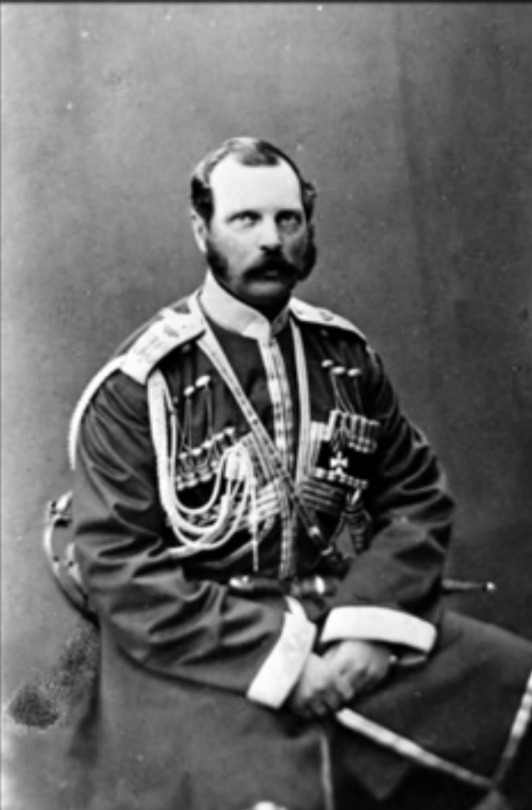


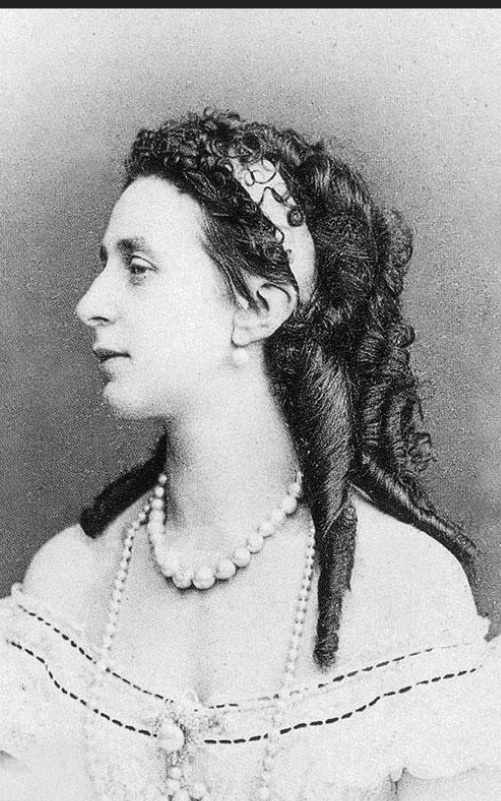

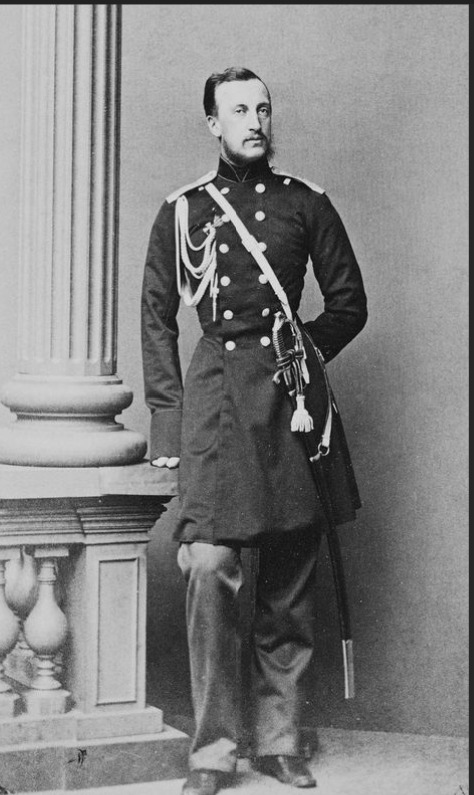

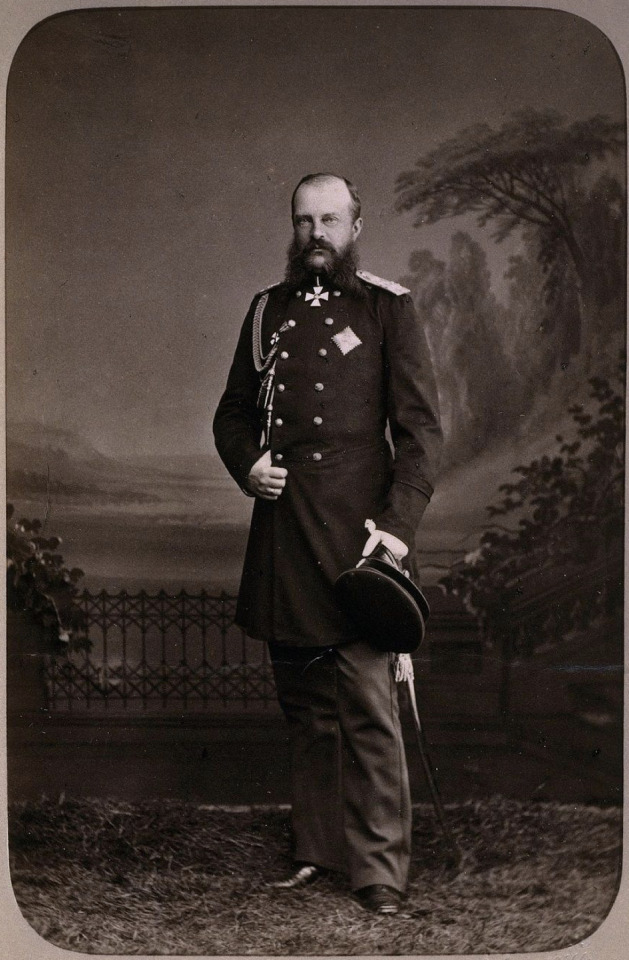
1. Emperor Alexander II and his first wife Empress Maria Alexandrovna (born Princess Wilhemine Marie of Hesse); Issue listed below (Only legitimate issue surviving to adulthood listed; not in birth order)
Grand Duchess Marie
Grand Duke Nicholas Alexandrovich
Alexander III
Grand Duke Vladimir
Grand Duke Alexei
Grand Duke Sergei
Grand Duke Pavel
2. Grand Duke Konstantin Nikolayevich and Grand Duchess Alexandra Iosifovna (Princess Alexandra of Saxe Altenburg); Issue listed below (Only legitimate issue surviving to adulthood listed; not in birth order) - They would be known as the "Konstantinovichi"
Grand Duke Nicholas
Grand Duke Konstantin
Grand Duke Dmitry
Grand Duke Vyacheslav
Grand Duchess Olga
Grand Duchess Vera
3. Grand Duke Nikolay Nikolayevich (the Elder) and Grand Duchess Alexandra Petrovna of Russia, born Duchess Alexandra Frederica Wilhelmina of Oldenburg. Issue listed below (Only legitimate issue surviving to adulthood listed; not in birth order); Known as the "Nikolayvichi”
Grand Duke Nicholas Nikolayevich
Grand Duke Peter Nikolayevich
4. Grand Duke Mikhail Nikolayevich and Grand Duchess Olga Feodorovna (nee Princess Cecilie of Baden) Issue listed below (Only legitimate issue surviving to adulthood listed; not in birth order) They were known as the "Mikhailovichi" (although they preferred to be called the "Michels;" the family called them the "Wild Caucasians" because they grew up in the Caucus and had strong opinions that they voiced loudly)
Grand Duchess Anastasia Mikhailovna
Grand Duke Nicholas Mikhailovich
Grand Duke Mikhail
Grand Duke George
Grand Duke Alexander
Grand Duke Sergei
Grand Duke Alexei
The children and grandchildren of these couples would be directly involved in one way or the other in the Great War, the Russian Revolution, the Civil War in Russia, and the overthrow of the monarchy and the Romanov Dynasty. Some would lose their lives, others would lose children, brothers, and spouses, and all would lose their country, status, and privileges.
#russian history#romanov dynasty#imperial russia#Emperor Nicholas I#Emperor Alexander II#Grand Duke Konstantin Nikolayevich#Grand Duchess Alexandra Iosifovna#Grand Duke Nikolay Nikolayevich#Grand Duchess Alexandra Petrovna of Russia#Grand Duke Mikhail Nikolaevich#Grand Duchess Olga Feodorovna#vintage photography
90 notes
·
View notes
Text
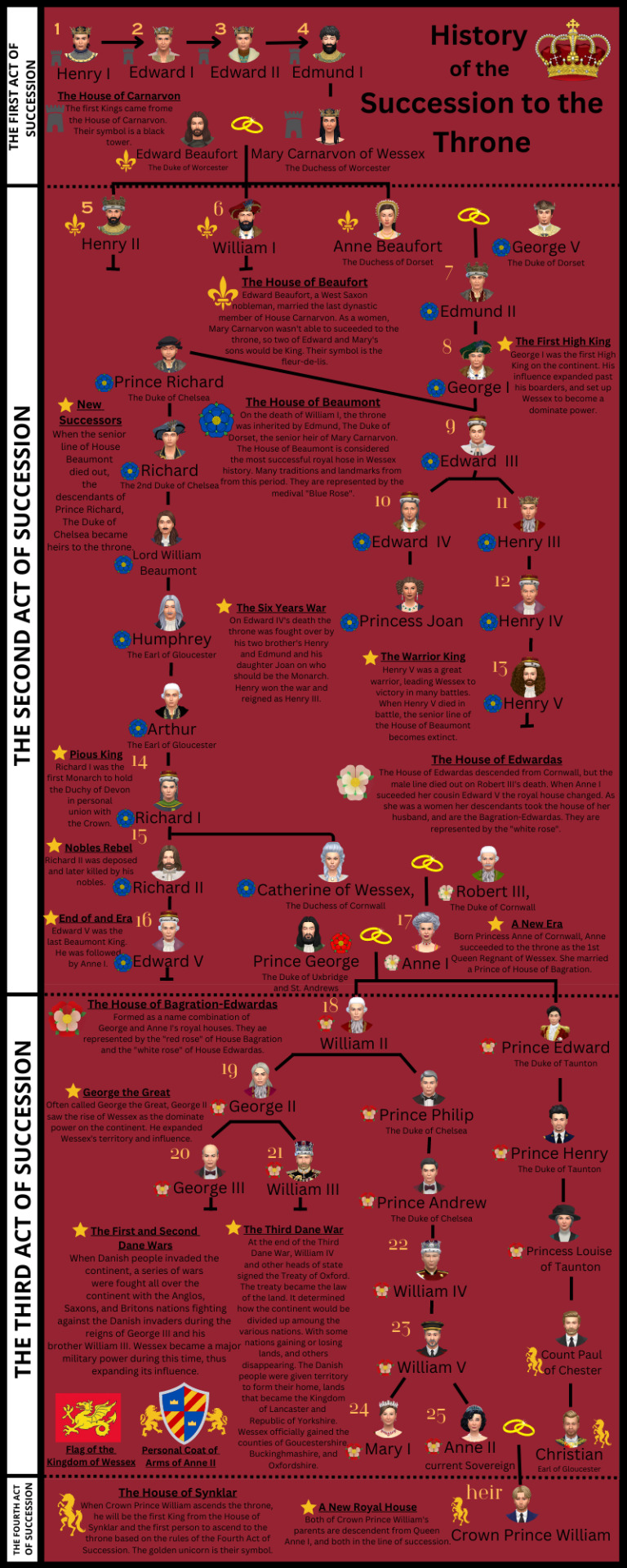
The History of the Succession to the Crown shows the historical succession to the throne of Wessex starting with the 1st monarch to rule from the throne, King Henry I of Wessex, at the top of the chart leading to the current sovereign Queen Anne II of Wessex at “25″ at the bottom.
The symbol/flower next to an individual is which royal house they belong to. There is also a brief description about each house that has ruled Wessex.
Note this chart only shows how each monarch is related to each other and their descent from Henry I of Wessex, not necessarily an entire family tree or the current line of succession.
The First Act of Succession
The First Act of Succession was established when Henry Carnarvon became the first King of a sovereign Wessex after the fall of the Saxon Empire. HE declared that the throne will pass through his male line, and it successfully passed from father to son until his great-grandson King Edmund I failed to produce a living male heir. When King Edmund I realized that there wouldn’t be any male heirs left, he signed the Enfield Declaration which declared the throne would pass the heirs daughter, Princess Mary Carnarvon of Wessex.
The Second Act of Succession
When Mary Carnarvon gave birth to her son, the future King Henry II of Wessex, The Second Act of Succession was officially passed, declaring that all possible claimants to the throne must descend from Princess Mary. Mary and her husband Edward Beaufort, The Duke of Worcester would go on to have five children, but only her youngest daughter Anne who married The Duke of Dorset would have any children to ascend to the throne.
The throne then passed to Anne’s son King Edmund II and passed neatly from father to son, until the death of Edward IV of Wessex. Edward IV has no male children, but he did have a daughter. Some nobles thought that Princess Joan (Edward IV daughter) was the rightful successor, while others thought that Edward IV’s brother Prince Henry, The Duke of Worcester was the more suitable heir.
Those who supported Princess Joan of Wessex argued that the Second Act of Succession referred to “heirs general” and as the senior heir of Princess Mary Carnarvon, and it didn’t matter that she was female. Those for Prince Henry, The Duke of Worcester argued that the Second Act of Succession only referred to heirs male and would only allow for a female succession if the male line of Princess Mary Carnarvon goes extinct. Henry’s supporters won and the throne then passed to Edward IV’s brother, who reigned as King Henry III of Wessex.
It wasn’t until Princess Anne of Cornwall ascended the throne as Queen Anne I of Wessex that Wessex got its first female consort.
The Third Act of Succession
On her accession, Queen Anne I decided to limit the possible heirs to the throne to only her descendants, thus ending any claims of other West-Saxon nobleman who descended from House of Beaumont, and wished to challenge her for the throne. All subsequent monarchs under the Third Act, and later Fourth Act of Succession, must descend from Queen Anne I and her husband Prince George Bagration to be eligible to the throne.
The Fourth Act of Succession
The Fourth Act of Succession is the current Act governing the succession to the throne. It has three basic rules. 1) an individual must be a descendant of Anne I through one of her five legitimate children, 2) members of the occult are banned from inheriting the throne, 3) and the line of succession follows male preference primogeniture.
Succession to the Crown Chart | Princess Royal Chart | Counsellors of the State | The Earl of Gloucester |
25 notes
·
View notes
Text

King Christian IX of Denmark had three daughters:
Princess Alexandra of Denmark (later Queen of United Kingdom) was born in 1 December 1844
Princess Dagmar of Denmark (later Empress of Russia) was born in 26 November 1847
Princess Thyra of Denmark (later Crown Princess of Hanover) was born in 29 September 1853
Princess Alexandra was a personality of an uncommon order. The gracious lady was graciousness itself. She was distinguished, not by any desire to enter into public affairs, but by a kindliness, a generosity, a sympathy with all classes, poor and rich, which endeared her to the whole people.Alexandra shared a draughty attic bedroom with her sister, Dagmar, made her own clothes, and waited at table along with her sisters. Alexandra and Dagmar were given swimming lessons by the Swedish pioneer of women's swimming, Nancy Edberg. At the age of 19 Alexandra married Prince Edward of Wales, the eldest son of queen victoria and Heir of Great Britain throne, Edward loved his wife but was not faithful to his marriage!the result of this marriage was 6 children. 🥰❤️
Dagmar was known for her beauty. Princess Mary Adelaide of Cambridge said that Dagmar was "sweetly pretty" and commented favorably on her "splendid dark eyes." Dagmar was intelligent, When considered Dagmar for queen victoria's second son Alfred, Duke of Saxe-Coburg and Gotha, Queen Victoria judged that "Dagmar is cleverer [than her older sister, Alexandra]... she is a very nice girl." At the age of 19, Dagmar married the Russian Tsesarevich Alexander, after the shocking death of her fiancé Tsesarevich Nicholas, who was Alexander's older brother. The result of their marriage was 6 childrenWhen she married, she didn't know how to speak any Russian. However, within a few years, she mastered the language and was so proficient that her husband, tsar Alexander iii wrote to her in Russian.🥺🤍
Princess Thyra As a child shared a bedroom with her elder sisters, Alexandra and Dagmar, and was taught how to sew and knit her own clothes and socks. Thyra was an attractive and gentle young woman, with dark hair and dark blue eyes, and king Christian and Queen Louise wanted their youngest daughter to make a good marriage as their elder daughters had. Thyra's first suitor was King Willem III of the Netherlands, but as he was thirty-six years older than she was, she rejected him.In her youth, Thyra had fallen in love with Vilhelm Frimann Marcher, a lieutenant in the cavalry, which resulted in a pregnancy. Her brother George I of Greece suggested that she have the baby in Athens to avoid scandal; the Danish press was told Thyra had been taken ill with jaundice. At the age of 25, Thyra married Ernest Augustus, Crown Prince of Hanover, and the result of this marriage was 6 children.🤩💗
32 notes
·
View notes
Text






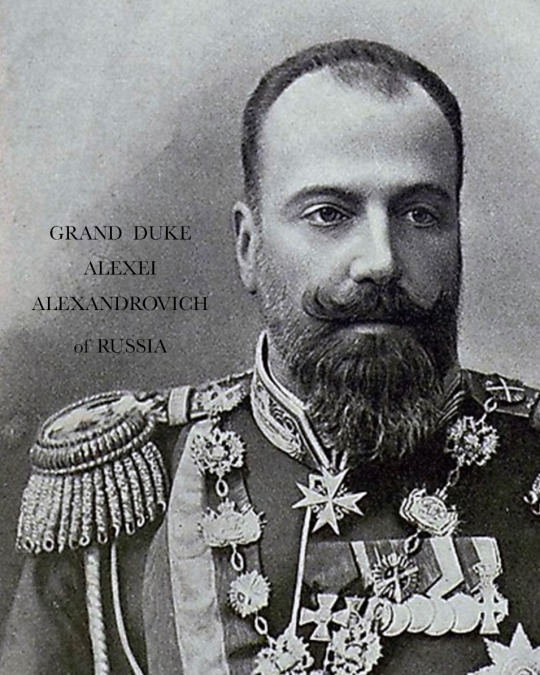

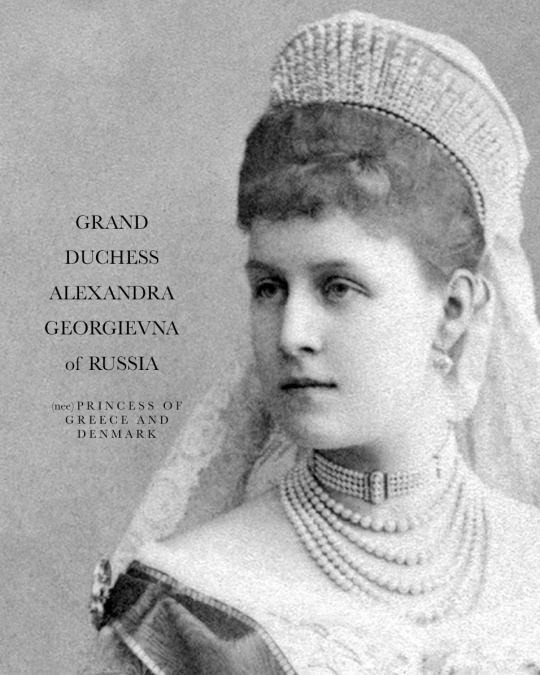
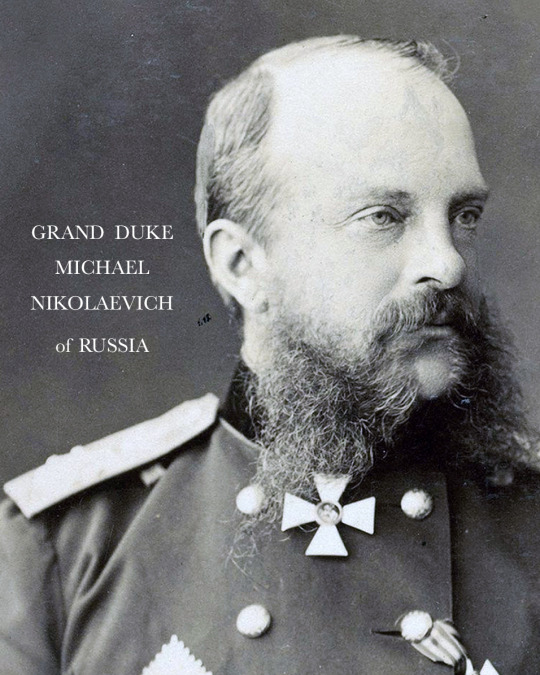



GODPARENTS OF PRINCE KONSTANTIN KONSTANTINOVICH
Prince Konstantin Konstantinovich was born on 1 January 1891 in Saint Petersburg, Imperial Russia. He was the third son and fourth child of Grand Duke Konstantin Konstantinovich of Russia and his German-born wife Grand Duchess Elizabeth Mavrikievna. Konstantin was christened on 3 January at 2 in the afternoon at Marble Palace Church, St. Petersburg, by the Confessor of Their Majesties. His godparents were:
ALEXANDER III, EMPEROR OF RUSSIA - his father’s first cousin was named as one of his many godparents. He was highly reactionary in domestic affairs and reversed some of the liberal reforms of his father, Alexander II. He was most likely present at his young cousin’s christening.
GRAND DUKE KONSTANTIN NIKOLAEVICH OF RUSSIA - his paternal grandfather and namesake was one of his numerous godparents. He was the Viceroy of Poland from 1862 to 1863. His real influence on internal affairs after 1868 was insignificant. He was reportedly absent at his grandson's christening, due to his ill health.
CHARLES ALEXANDER, GRAND DUKE OF SAXE-WEIMAR-EISENACH - his parents' distant cousin (as a grandson of Emperor Paul I of Russia) was also named as the young Konstantin's godparent. He was absent at the prince's christening. He was the penultimate ruler of Saxe-Weimar-Eisenach, from 1853 until his death in 1901.
QUEEN MARIE OF HANOVER - his great-aunt, the last Queen consort of Hanover, was amongst his numerous godparents. She was absent at his christening.
ELISABETH, GRAND DUCHESS OF OLDENBURG - another of his great-aunt named as his godmother. Elisabeth, upon her marriage to the Grand Duke of Oldenburg used the funds given to her by her father to set up the Elisabeth Foundation, which still exists today. Like her sister Queen Marie, she was absent at her great-nephew's christening.
GRAND DUKE ALEXEI ALEXANDROVICH OF RUSSIA - his father's illustrious first cousin was named as the prince's godfather. Chosen for a naval career, Alexei started his military training at an early age. By the age of 20 he had been appointed lieutenant of the Imperial Russian Navy, eventually becoming general-admiral.
GRAND DUCHESS ALEXANDRA PETROVNA OF RUSSIA - his great-aunt, the wife of Grand Duke Nicholas Nikolaevich, was another of his godmothers.A plain, and serious woman, her marriage to Grand Duke Nicholas was an unhappy one. Nevertheless, she would enjoy and maintain a good relationship with a few of her nephews including Emperor Alexander III and Grand Duke Konstantin Konstantinovich, who were sympathetic to her.
GRAND DUCHESS ALEXANDRA GEORGIEVNA OF RUSSIA - his paternal first cousin, the eldest daughter of King George I and Queen Olga, had been present and named as a godparent of Prince Konstantin, who was merely nineteen years her senior. In 1889, she married Grand Duke Paul Alexandrovich, the youngest brother of Emperor Alexander III.
GRAND DUKE MICHAEL NIKOLAEVICH OF RUSSIA - his great-uncle was also listed as his godparent, and had been present at the christening. A soldier for most of his adult life, he enjoyed a favourable relationship with the three last Emperors of Russia - his brother Alexander II; nephew Alexander III; and great-nephew Nicholas II.
GRAND DUKE PETER NIKOLAEVICH OF RUSSIA - his father's first cousin was another of his many godparents. He was the younger son of Grand Duke Nicholas Nikolaevich and his wife grand Duchess Alexandra Petrovna (also named as a godparent of Prince Konstantin, listed above).
PRINCESS AUGUSTA OF SAXE-MEININGEN - his maternal grandmother was also named as his godmother. In 1862, she married Prince Moritz of Saxe-Altenburg, and bore him five children.
PRINCESS LOUISE CHARLOTTE OF SAXE-ALTENBURG - his maternal aunt, the youngest sister of Grand Duchess Elizabeth Mavrikievna was amongst his numerous godparents. Both Louise Charlotte and her mother Augusta were absent at Konstantin's christening.
Source
16 notes
·
View notes
Text
The many faces of John Quincy Adams based upon his portrait by John Singleton Copley.
In 1797, Abigail Adams, wife of John Adams, quite unexpectedly received a shipping case. It contained this portrait of her twenty-eight-year-old son by John Singleton Copley, which Mrs. Susanna Copley had asked her husband to paint as a gift for her old friend. Abigail was delighted, and she wrote to John Quincy Adams on June 23, 1797, “It is allowed to be as fine a portrait as ever was taken, and what renders it peculiarly valuable to me is the expression, the animation, the true Character which gives it so pleasing a likeness . . . It is most elegantly Framed, and is painted in a masterly manner. No present could have been more acceptable.” John and Abigail Adams had visited London in the 1780s and had become friends with the artist and his wife, and Copley had painted a full-length portrait of John Adams in 1783. Copley had also painted a likeness of Abigail Adams, daughter of John and Abigail Adams, probably at about the same time, which was subsequently destroyed by fire.
John Quincy Adams responded to his mother in a letter dated July 29, 1797, enlightening her on the circumstances under which his portrait had been painted:
"The history of the Portrait which you received last March was this. While I was here, the last time, Mr. Copley told me that Mrs. Copley had long been wishing to send you some token of her remembrance and regard, and thinking that a likeness of your Son, would answer the purpose, requested me to sit to him; which I did accordingly and he produced a very excellent picture, as you see. I had it framed in a manner which might correspond to the merit of the painting, and after I left this Country it was sent out by Mr. Copley. . . . It is therefore to the delicate politeness of Mr. and Mrs. Copley, that we are indebted for a present so flattering to me, and in your maternal kindness so acceptable to you. They are well, with all their family and continue to remember you with affection."
John Quincy Adams was serving as the United States Minister to the Netherlands in 1796 when he sat for Copley, having been appointed by President George Washington in 1794. He was resident in London for several months in 1795 and 1796 to conduct negotiations concerning the ratification of the Jay Treaty, which resolved many issues remaining from the American Revolution. Even though Adams was a relatively young man, he had been chosen for these important positions because of his extraordinary education and upbringing. Since he had often accompanied his father when he was sent to Europe on government business, the younger Adams had traveled to France, Spain, the Low Countries, England, the German States, Russia, and Sweden by the time he was seventeen. Often John Adams’s business required lengthy stays, and John Quincy Adams had therefore been enrolled in schools in Paris and Amsterdam. Back in the United States in 1786, Adams entered Harvard College, was elected to Phi Beta Kappa, and graduated the following year. Subsequently he studied law in Newburyport, Massachusetts, and then began to practice law in Boston.
Adams recorded seven sittings for his portrait from February to April 1796. Two of the notations provide an elucidating glimpse into the experience of posing for Copley. On March 4 he wrote: “At Mr. Copley’s all the morning sitting for my picture. Conversation with him political, metaphysical, and critical. His opinions not accurate, but well meaning.” On March 28: “At Mr. Copley’s all morning, sitting again for my picture. Stayed there too long gazing at his Charles [Charles I ], and at a portrait of the three youngest princesses [The Three Youngest Daughters of King George III, 1785, Royal Collection, United Kingdom], a finely finished thing.”
In a stylish oval format, the portrait shows a rather debonair John Quincy Adams with powdered hair, dressed in a black frock coat with a white stock and a glimpse of a pink waistcoat. He is set against a red curtain and a crepuscular landscape. Copley carefully delineated Adams’s features but painted the costume and background with dashing and loose brushwork.
Shortly after the portrait was completed, Adams became engaged to Louisa Catherine Johnson in London. He went on to a brilliant political career, serving in the United States Senate, as Minister to Russia, as Minister to England, and as Secretary of State. In 1825 he was elected the sixth president of the United States, and after he lost his bid for re-election, he represented Plymouth, Massachusetts, in Congress for the rest of his life. Adams also went on to have his portrait painted by many of the leading artists of his day; in all he sat for at least sixty likenesses. Of all these portraits, Adams decided that “Copley’s Portrait of 1796, Stuart’s head of 1825, and Durand’s of 1836 . . . are the only ones worthy of being preserved.
#founding fathers#presidents#john quincy adams#digitalyarbs#amrev#american revolution#historical figures
12 notes
·
View notes
Text
To Those We Hold Tight

Also available on ao3!
Summary: With three boys so far, the King and Queen hope for a daughter.
Pairings: Queen Charlotte/King George III, King George III & his daughter, The Princess Royal Charlotte (Charlotte Augusta Matilda Queen of Württemberg)
Characters: Queen Charlotte, King George, George IV of the United KingdomFrederick Duke of York and Albany, William IV of the United Kingdom, Charlotte Augusta Matilda Queen of Württemberg
Words: 3000
Status: Complete!
~~~~~~~~~
September 1766
Charlotte embroiders in the quiet comfort of her husband’s bedchamber. George loves to watch her delicate hands find their way in and out of the fabric, painting with thread. When she is in the room, he finds it difficult to focus on anything.
The light of the fireplace envelops the royal couple in a soft, flickering orange glow. It is there in his room they can strip the formality of their everyday lives, to become George and Charlotte– no other titles necessary. The room is quiet save for the crackle of the fireplace and the soft scratches of graphite on paper. Both steal glances of the other when they are not looking.
Her King sits across from her, legs crossed in the armchair, planning his garden plots. His face betrays nothing but pure concentration. He will meet up with the gardeners at Kew to discuss his ideas, but for now he is lost in thought.
“I hope you do not think me terrible for saying I wish this one a girl,” says Charlotte, stopping mid-needlework to look at her husband sheepishly. From underneath her nightgown, there is no hiding how big she is. Charlotte feels she is nearly about to burst.
George looks up from his work and sets his paper down on the table beside him. He moves to take his place beside his wife on the settee, having been reminded how long it has been since he had last kissed her.
“No,” he says honestly. “I do not.”
“In fact, I say I feel similarly,” he says with a twinkle in his eye. He kisses her lips first, before gently making his way down to her neck. The tension she was holding in her shoulders melts away and she is swept away by his touch. Each stroke, kiss, caress, and touch is a word in a language only they know. He writes love letters on her skin.
The baby stirs. She places his hand on her stomach, inviting him to feel. She is used to this strange sensation, the feeling of life within her, and thinks back to her original comment. The coin has been flipped. Whichever he or she shall be, they do not know yet. Of course she will love any of George’s children, but that does not make her desire for a daughter abate.
The pair love their sons dearly, but three rambunctious toddlers have left them both longing for something different. Their situation is unusual: many might wish only for sons and nothing less. They had secured the heir, a spare, and a spare for the spare in due course. Perhaps they believe a girl will be easier to raise. Or perhaps they know, as do most of the aristocracy, a girl is often easier to control.
—
When the Princess Royal Charlotte is born, her exhausted parents breathe a sigh of relief.
The King and Queen present their daughter to their sons. The eldest, Georgie, is not yet four, the youngest, William, just barely over a year. They gaze upon her, a baby with jet black hair wrapped in their mother’s arms, unsure of what to do with the thing.
When the boys are sent to bed, George takes the bundle from his wife and cradles her in his arms. Each child different than the next in his arms, each one undoubtedly eliciting pride and joy as he gazes down at what they’ve created. The Queen beams at them both, exhausted, before slipping into a deep sleep. George leaves with the baby, attendants shutting the door quietly behind him, and the infant Charlotte is nothing but epitome of perfection. She snoozes peacefully, blissfully unaware of her new life on this earth or her place in the palace.
June 1772
A man in a nearly see-through linen shirt left little to the imagination, especially when that man was her husband.
King George is Farmer George today, dressed in a common man’s breeches and shirt, strutting about the gardens with a fierce sense of purpose. It is those days he feels most himself, most connected to the earth and to his place in it. He is a humble speck in the universe. Not a king, not chosen, simply George. He tends to his gardens like an Everyman.
The Farmer King is freshly thirty-two. For all the pomp and grandeur that accompanied a royal’s birthday, he did not feel much comforted by the passage of time. The Americas were becoming more and more a disfiguring pockmark on his reign, a question without an answer. Whatever he chose to do or not do felt like entirely the wrong answer. He was a silly king who had never been taught how to properly come into his role. To fail on all fronts seemed to have been prophesied, and who was George to trifle with God about such matters. The only thing he could venture to do to retain what was left of his sanity was to shut the world out, to occupy fully the role of father and of scientist.
Often, Charlotte would make her way into the garden too (save if it was too hot or she too pregnant), Reynolds always by her side, holding a parasol as she watched her husband diligently. She could remember that moment years ago when she had watched him from the window, unable to comprehend why a man like him wanted to farm.
Even on the long summer days when the sun shines brightly in the sky and when the heat of the eager sun threatens to bring her inside, still she watches. There are times when he is so enraptured with his work even her presence can not break his concentration. Charlotte likes those moments most, when she can peer into his mind as a gentle observer, watching as he enjoys the peace and prosperity he deserves in every second of his life. When the fantasy is gone and when royal duties demand attention, Farmer George transforms before her eyes into King George. She loves them both fiercely, but most of all the man underneath both costumes, the Just George who plays both roles.
Their boys burst from the french doors like cannons, chasing each other with wooden swords. They’re dressed in a variation of George’s farming outfit, with loose linen shirts and breeches, an innovation of their father in the aftermath of some very expensive fabrics being torn and muddied beyond recognition. If he was to have a common man’s outfit, so too should his sons.
Today, Charlotte is not overly pregnant and the weather is agreeable. As to the first point, she is not quite sure if she is with child, though her courses have come late and eight times of prior experience leaves little doubt. Perhaps she will tell George tonight, or save it for another evening when he needs cheering up. It would be such a disappointment to bring both their hopes up only to have a doctor shoot their dreams down.
She watches from a bench in quiet consideration, book in hand, her young boys growing taller and taller by the day, soon to be young men. Georgie is eleven now, three inches taller than his younger brother Frederick and unafraid to let him know it. William is not nearly seven yet, but tags behind his brothers anyways, hoping that their duo could one day be a trio. She is too far away to hear what her husband says to their children, but she knows George delights in his children’s presence.
George looks up when the boys come bounding outside. Sometimes he was apt to chase them, to excite their energies even further (and hopefully, when it came time for bed, to make the experience easier after a long day playing in the sun). William comes running at his father full tilt, and George obliges by crouching down to pick the young boy up. Soon he has a posse of his sons encircling him, all catching their breath.
“Georgie, play nice,” George says to his eldest son. “You too, Frederick.” He gives them a not-quite-pointed glance, before grinning.
“And you,” he says to the child in his arms, “You go show them who's boss.”
William beams at his father and nods, before being set back down. The trio bolts, only one heeding their father’s advice, to play in a fantasy world of their own making. Perhaps they’ll imagine themselves as princes in their new world, or perhaps, like their father, they will go where royal expectations cannot touch them.
With great delight George realizes his eldest daughter has come to pay him a visit. The five-year-old is adorably dressed in a white cotton frock with a pale blue sash, running with delight towards her father before he picks her up and throws her into the air. She shrieks in delight as he catches her and he cannot help but laugh.
It was difficult not to play favorites when it came to the younger Charlotte. The Princess Royal was, thankfully, a spitting image of her mother, with bright brown eyes and a head of tender black curls. Out of all eight children the royal couple had produced, none other than Charlotte had the most fitting name.
“What did you learn today?” asks George, tucking a stubborn tendril back behind her ear. It was a customary question, one which the five-year-old Princess was eager to answer.
“Letters,” she said proudly. George grins.
“Letters?” he asks animatedly, as though each word she said to him was the most interesting thing in the world. Which it is.
Charlotte nods. “All of them.”
“All of them?!”
The girl laughs and nods again, trying to convey to her clearly daft papa that they did indeed work on letters today.
“Well,” George says, “then you will soon be reading like your mama. Do you see her?”
George turns around, the Princess Charlotte on his hip, and waves at his wife from afar. Their daughter joins in, and the Queen acquiesces, giving a hearty wave back. She is glad of the vignette of her Farmer George and their children. She will covet the memory closely to her heart, escaping to the good memories when the world seemed to crash down upon them both.
Queen Charlotte retreats to the palace where her mind is preoccupied with royal duties, from arranging invitations, scheduling visits, replying to various correspondence, and a whole barrage of other things that seem silly to waste one’s precious 24 hours in this life on. She often felt at odds with the world, distant from her children when the royal duties beckoned her back to the inescapable title of Queen. She was either Queen Charlotte or she was Mama, never truly both at the same time. George could somehow be everything all at once.
George sets his daughter down on the pathway, taking the hand that’s nearly a quarter the size of his own in his, leading her towards the Orangery.
“Do you like your tutors?” he asks. Perhaps it was unusual for a King royal to bring so much care and attention to the education of his children, but George had been determined to break and bend the traditions of his Hanoverian past. The Hanovers had a long history of cheating on their wives and hating their sons. Only his father had broken the tradition of the latter, but he had left this world by the time George was thirteen. The first true born and bred English King was not going to follow in the footsteps of his ancestors.
“Oh yes,” says his little girl with gusto. “I have fun.” She thinks a minute before adding, “Sometimes.”
“And français?”
She nods. He raises his eyebrows at her.
“Oui,” she giggles, catching on.
“Très bien,” he says, nodding approvingly. “And Deutsch? ”
“Ja!” answers the little voice. “Mama helped.”
“Oh?” Queen Charlotte was apt to guide her children’s education. George is unsurprised to hear it, and rather quite proud. If there was anything that her children were going to learn, it was her mother tongue. He is glad to hear it.
Charlotte stops mid-walk to give him the eyes of a beggar. It was a cheap trick and they both knew it, but the King was eager to oblige. Perhaps a stronger willed father would not humor her, telling his daughter that she was five years old and could walk perfectly well with her big girl legs. But he cannot. He will let his children be children for as long as they want. He had not been afforded that simple luxury himself.
He picks up the delighted child once more and his heart melts as she nuzzles herself into his shoulder. He can forget the world at this moment. The bickering in Parliament, the disquiet in the Americas, the ever-present mental illness that loomed over his every action. He isn’t a Farmer, he isn’t a King, he isn’t sick. He is a father. Her father.
They reach the Orangery, a stunning white brick and stucco building that bears the arms of George’s mother and father. Seven large, arresting arched windows frame the front of the building. From afar he can see the red-brick facade of the palace, sitting in stark contrast to the bright white of the Orangery. He wonders if that’s where his Queen has retreated.
Attendants open the stately doors to let the pair inside. He almost objects, but he is for once glad of the chance to keep both his hands free to keep his daughter tight to him. The Princess gasps in delight at the wide array of plump citrus in front of her. George lets her pick out her favorite one, which she pulls off of the great tree in front of her.
He smiles to himself, knowing that her mother had once done the same. Such a small act of defiance and autonomy, but she had done it nonetheless.
The ceiling in there is high, the branches and leaves stretching to the very top. The citrus trees eagerly soak up sunshine from the grand windows. It is an explosion of greenery with spots of orange and the two royals are delighted.
“Your grandmother had this built, did you know?” says George, melancholy lining the edges of his voice. Charlotte shakes her head, the memories of her grandmother more of a mist, soon to be forgotten in time.
The Princess Dowager Augusta had died that year, not four months prior. She and her son had a deeply complicated relationship, where often duty was confused with love or something similar to the feeling, but now that she was gone there seemed to be few he could rely on. Maybe her sharp edges might have been dulled if his father had remained alive, if he had taken on the mantle of king instead of George himself. He can (and has) spent days mulling over the what ifs, though its effect on reality was negligible. There is only the here and now.
“Grab one for your mama,” he whispers. Charlotte obeys dutifully, grabbing another off the branch and handing it to George. He tucks it away safely in his pocket.
As they exit, the young princes nearly come crashing into them. Seems he was right about wanting a daughter , he thinks with sardonic amusement.
They look at their father, wide-eyed, unsure what he’s going to say next. George is not in the mood to be mad, and the look on their faces is apology enough.
“Oh go on,” he says, and ushers them away. “Go grab an orange and go back to the palace. Afternoon lessons will be starting soon, will they not?”
“Yes, sir,” says Georgie quickly.
The band of brothers release a breath of air, tucking their swords away and bounding into the Orangery. George and Charlotte take their leave, but are outpaced by her brothers within fifteen paces. There was nowhere the young princes would not go without sprinting.
When they return to the palace, clothes will be changed and roles will be carefully put back on. Royal titles and duties will resume. There will be people to meet, places to go, decisions to make.
When George returns he is dressed in a fine silken navy blue waistcoat and matching breeches. Gold embroidered flowers paint the edges of his jacket, a showy reminder that he is no longer a common man and never was. George finds his wife at a desk, scribbling away. Her robe à la français , the navy blue gown which she’d been wearing all day, now seemed to be part of a matching set.
Charlotte turns around at the sound of his footsteps. She knows him. Even when he is down the hallway or outside, she knows the pace and weight of his feet on the ground.
“I have a surprise for you,” says George in the doorway. From behind his legs, Charlotte can see the outline of her daughter. The Queen grins. George steps aside and the Princess Royal runs to her mother, brandishing her orange. There he is again: the man who is her husband, her King, and the father of her children, all at once.
“For me?” she says with delight as the little girl nods heartily. “It is lovely, thank you.”
“She picked it herself,” says George. “Just like her mother.” Charlotte stares into her husband’s eyes and she cannot imagine a more perfect man.
The Princess runs out the room to her governess, who takes the young child away and back to her lessons.
“I have a surprise for you as well,” says Charlotte, turning over the fresh fruit in her palms. She does not need to say any more, for they have done this song and dance eight times. Each time, though, he finds himself forever surprised.
“Oh my darling,” says George, inviting her to stand up from her chair. His hands find her hips and his lips find hers.
“You are the brightest star on this earth.”
#queen charlotte fanfiction#queen charlotte#king george bridgerton#bridgerton fanfiction#bridgerton fanfic#charlotte x george#charlottegeorge
20 notes
·
View notes
Text




Happy 56th birthday to King Willem-Alexander of the Netherlands!
Born on April 27 1967, Willem-Alexander Claus George Ferdinand acceded to the Dutch throne following his mother's abdication in 2013. On the day of his accession he became Europe’s youngest monarch, as well as the first male monarch of the Netherlands since his great-great-grandfather William III in 1890.
He married Máxima Zorreguieta Cerruti in 2002 and they have three daughters: Catharina-Amalia, Princess of Orange (19), Princess Alexia (17), and Princess Ariane (16).
20 notes
·
View notes
Text
Umbrella Pharmaceuticals - Chapter 20
I
Alexander and Tony stowed their luggage in the boot of the sedan. They were travelling to Zaire to see the fight between Muhammad Ali and George Foreman.
Tony had said goodbye to each twin with a big hug and a kiss on the cheek. Alexander had hugged Alexia and stroked Alfred's hair.
Alfred had wanted a hug just like his sister's, but Alexander had walked away ignoring his plea. He had to ask Elizabeth to hug him to feel as loved as his sister.
II
The last descendants of the Stewart dynasty residing in the United Kingdom gathered at Ashford Hall to celebrate Christmas '74. The youngest members of the household, who were Alexia and Alfred, Auguste and Amelia, had been dressed in a kilt and accessories. After a frugal dinner at which the adults were more vocal than the children, Auguste had the idea of playing at being kings and queens of Scotland. Auguste chose to be James VI, Alfred to be Robert II and Alexia to be Mary I. One-year-old Amelia, Auguste's little sister, was put to bed early by her parents for Santa to come.
The three monarchs ensured the peace and prosperity of their kingdoms by allying with each other. But the golden age was short-lived. In a radical geopolitical twist, Mary I secretly allied with Robert II to plot against James VI and seize the throne. At the stroke of midnight, Mary I and Robert II cornered James VI in the gambling hall, but James VI surprised both kings with an unexpected ploy. Suspecting that Mary I and Robert II would oppose him, James VI took the opportunity to grab a large cardboard box, which he moved by brute force and placed on top of two flimsy LEGO towers. He said the box and the towers symbolised his court. So, when cornered, James VI requested an audience on the spot. The pair of conspirators agreed and sat right under the box. In a moment of distraction, James VI threw down the towers and the box fell like a cage on the conspirators. However, Mary I was more agile and escaped with the collapse of the first tower. Robert II was trapped inside the box, kicking and insulting a grinning James VI. Mary I faced her formidable foe.
A rain of blood showered the fields of Scotland as Mary I and James VI engaged in an all-out battle that involved kicks and punches to the body. James VI staked his victory on extraordinary strength and fortitude and Mary I on her intelligence, with which she was able to accurately predict her opponent's attacks and know his weaknesses.
When the duel began, Robert II managed to slip under the box and witness the contest. Mary I was bleeding from her lip and a bruise marred James VI's knees. Robert II tried to intercede, but was stopped by Mary I, who preferred to settle the matter alone. Robert II would intervene when strictly necessary.
The fight ended in a draw. Mary I and James VI were put to bed and punished without Christmas presents until their next birthday. Robert II and Amelia were the only ones to receive their presents on the twenty-fifth.
III
The children crowded into the corridor to enter the classroom. They were shouting and laughing, jostling and whispering.
As they passed through the corridor, some of them noticed a girl leaning silently against the wall and sitting on a stiff wooden bench. Although dressed in uniform, she had never been seen in class. It was rumoured that she might be the daughter of one of the teachers, but this rumour was disproved when a couple of girls discovered her alone in a small classroom on the first floor. Hers was the only desk available, apart from the teachers' desk.
The discovery was quickly shared as gossip from the youngest to the oldest. It was the latter who were encouraged to demonstrate the various speculations about this mysterious girl. It was said that she might be grounded or in need of special attention. Since none of the hypotheses seemed conclusive, a group of eleven-year-old schoolchildren resolved that they would not leave the school without finding out who she was.
One member of the group formed for the mission watched the girl sitting on the wooden bench from the other end of the corridor. The girl seemed unsettling to him, as if she were from another world. She was about four or five years old and did not behave like any infant he had ever met. She wasn't smiling, she wasn't particularly amused; she just sat there, hieratic, as if she were at a reception rather than a school. Despite the boredom, the schoolboy did not give up. As luck would have it, a blond, bearded man in his forties came out to meet her.
"Alexia, we are leaving," said the stranger in Queen’s English[1].
The girl, Alexia, stood up and left with the stranger. The schoolboy followed them cautiously out of the grounds. Outside, an expensive chauffeur-driven car was waiting for them. The schoolboy ran to join the rest of the team to announce that the target had left. The group then ventured into the second phase of their plan: sneaking into the classroom.
Outside the building, the lightest member of the group was hauled outside and used a thin metal plate to undo the lock and gain access to the room. In the classroom, the intruder inspected the teacher's desk, where she found a folder containing valuable information. The student identified herself as Alexia Mary Victoria Elizabeth Anne Ashford-Campbell-Douglas-Stuart; in brackets: Alexia Ashford. She was four years old and, as she read four times, was preparing to sit her O-Levels next term and her A-Levels in two years' time, at the age of six. In a section of notes, teachers were instructed to direct her education towards her admission to Harvard University, from which Alexia had received an invitation. Another piece of paper enclosed a weekly timetable, Monday to Saturday, starting at 7:30 a.m. and ending at 9 p.m. She did not understand the esoteric names of the subjects, but counted that there were about ten of them, and only for O-Level. Another sheet of paper contained the result of an intelligence test: 171[2]. He read the extract from an essay written by Alexia. She barely understood a tenth of the words. Frightened, she put the papers back and slipped out of the window.
The intruder reported that the girl's name was Alexia, that she was a genius and that she was studying for admission to Harvard. The schoolchildren scoffed in disbelief and then joked about what a weirdo she must be, that she must be a bore and that she couldn't play or have fun like them. An arrogant, lonely freak who would never be admitted to their group.
IV
"Alfred Robert William Edward Malcolm Ashford-Campbell-Douglas-Stuart," said the teacher.
Alfred raised his hand. A boy two years older than him grimaced at him. Alfred ignored the gesture and went about his business, indifferent to the course of events. The last boy raised his hand. The teacher got rid of the list and went to the blackboard to start the maths lesson. He had started primary school at the age of four and it showed. Elizabeth and his father advised him not to draw attention to himself and to focus on the subjects. Alfred half understood their advice and complained about Alexia enjoying a class to herself. His father told him that Alexia was different and therefore needed her own curriculum. But Alfred still did not understand why Alexia was different. To him, his sister was his peer; that Alexia took less time to learn the things she was told to do was indifferent to him. They understood each other, just as they both understood their cousin Ogie[3] and Ogie understood them both.
He used to play football at recess. However, doing the same thing every day encouraged him to seek out new diversions such as hide-and-seek and sand. He befriended some boys who took him into their six-year-old group because of the witty antics he imagined. However, their company seemed insufficient to alleviate the loneliness he felt. If only Ogie were with him, he would have had a better time, but his cousin lived in Scotland. Alexander wasn't much help either. He accompanied Alexia at all times and it seemed that she was his only concern. It was as if a wall, like the one at his school, stood between him and his father; an impassable wall, with another brick being laid every day. He clung to Elizabeth, but his grandmother had temporarily returned to the Netherlands to attend to her business and family affairs. His only solace: meeting Alexia again from 9 p.m. onwards. Their time was limited, but they managed to play and talk about different subjects, miss Ogie and forget their worries.
And the loneliness vanished.
Notes:
[1] Received pronunciation. Associated with the British upper class.
[2] Terman's Stanford–Binet Third Revision (Form L-M) classification (1960).
[3] Family nickname of Auguste Campbell, cousin of Alfred and Alexia Ashford.
4 notes
·
View notes
Text

GEORGE BOLEYN, LORD WILTSHIRE. written by jules (she/her) for BLOODYDAYSHQ.
navigation / musings
BULLET POINTS
name: george boleyn.
moniker: the fervent.
age / date of birth.: 51, born 1497.
status / rank: earl of wiltshire, (former) lord protector.
country of origin: england.
place of birth: blickling hall, norfolk.
birth order: youngest brother of his two sisters.
mother and father: thomas boleyn, first earl of wiltshire (father), elizabeth howard (mother).
siblings: anne boleyn, queen dowager, mary carey nee boleyn, chief lady of the dowager's bedchamber.
children: richard boleyn, biscount of rochfort (son), countess of essex (daughter).
gender, pronouns: cis man, he/him.
sexuality: bisexual, biromantic.
horoscope: scorpio / leo / taurus.
virtues: ambitious, calculating, proud.
vices: shrewd, overzealous, uncharitable.
marital status: married, to jane boleyn, countess of wiltshire
religion: protestant.
allies: william iii, the boleyn faction, those allied with the boleyns.
adversaries: anyone against whatever the fuck it is george / the boleyn faction are up to, at any given time, but especially the seymours and courtenays.
BIOGRAPHY / TIMELINE*
+ 1508. birth to thomas boleyn and elizabeth howard, the third surviving child of their three children, in blicking hall, norfolk.
+ 1523. the ambition of thomas boleyn drives george to familiarize himself with the workings of the court for the first time; he is marked immediately as a charismatic young man with plenty of political suave and potential, something george will quickly learn to take advantage of.
+ 1524. marriage to jane parker.
+ 1528. birth of his son, richard boleyn, by jane boleyn nee parker.
+ 1530. birth of his daughter, countess of essex, by jane boleyn nee parker.
+ 1532. anne boleyn and henry viii are privately married. george fully ingrains himself into the royal household, staying as closely to his sister as he can while mind his own family.
+ 1537. seymour subterfuge.
+ 1538. as tensions grow between the boleyn faction and those who would claim anne's children to be illegitimate, george cleverly pulls strings wherever possible and bloodies his hands to remove any opposition who challenge william's claim to the throne. his reputation changes from that of a cunning if not charismatic man to someone far more cruel.
+ 1545, 1546. a warrant for anne's arrest is signed. george nearly tears himself and those closest to him to pieces during this time. when anne is released, he conspires with her and other members of the boleyn faction to see thomas cromwell ousted from the good graces of henry viii.
+ 1557. henry viii dies. william is put on the throne. george is instated as lord protector.
+ 1558. execution of the earl of devon. george urges william to take a severe hand to not just hugh courtenay, but to anyone who dares question his rule or openly professes vitriol for the dowager queen. rumors begin to spread of george's desire — and, perhaps, very real ambitions — to remove any royal persons from the line of succession that aren't william or elizabeth.
+ 1559. present day. anne is married to thomas wyatt. it's becoming clear that those rumors of george's bloody-mindedness are, perhaps, not rumors at all.
written biography tbd.
*dates subject to change / adjust / be removed where required.
7 notes
·
View notes
Text
24 Days of La Fayette: December 6th - Major Carter Page
The American born Carter Page (1758 to April 9, 1825) was La Fayette aide-de-camp from June of 1781 until November of the same year. Six eventful months in total. But his war service started long before his stint as La Fayette’s aide-de-camp. Page was commissioned a Captain of the 3rd Virginia Regiment, a Regiment of Dragoons, under the direct command of Colonel George Baylor, on April 10, 1778 – the Marquis de La Fayette in his position as Major-General was the commander of the whole division. On April 11, 1778, George Washington wrote to Colonel Stephen Moylan:
Capt. Jones and Lieut. Page have not been in Camp to my knowledge.
“From George Washington to Colonel Stephen Moylan, 11 April 1778,” Founders Online, National Archives, [Original source: The Papers of George Washington, Revolutionary War Series, vol. 14, 1 March 1778 – 30 April 1778, ed. David R. Hoth. Charlottesville: University of Virginia Press, 2004, pp. 479–480.] (09/04/2022)
Washington still referred to Page by his former rank. While the muster rolls of Valley Forge noted his commission in April 1778, they did not note the date of his arrival at camp. Page came from a prominent Virginian family, and it is therefore no too surprising, that he was made a Captain by the age of 19/20. Further promotions were scarcer, though by the end of the war he had been promoted to the rank of Major. On May 18, 1781, La Fayette wrote in a letter to Nathanael Greene:
There are also Some few Volunteer Gentlemen Under Captain Page. They are Very clever But Volonteers. We Had Some Militia Horse. Their time Was out and they Went Home this Morning. Happy I Have Been that we Have Got Some Accoutrements furnished to them By the public.
Idzerda Stanley J. et al., editors, La Fayette in the Age of the American Revolution: Selected Letters and Papers, 1776-1790, Volume 4, April 1, 1781-December 23, 1781, Cornell University Press, 1981, p. 110-114.
Carter Page was at this point in time not yet one of La Fayette’s aide-de-camps and I actually knew of only one letter that La Fayette wrote Page while the latter served in the described capacity. The letter was written on July 5, 1781 and the Marquis instructs the Captain that the British allegedly plan to infect the population of the Williamsburg area with smallpox. La Fayette instructs Page to come up with ideas to thwart this design.
Carter Page was born to Jane Byrd (Page) and John Williamson Page. He was brother to f Mann Page III, William Byrd Page, Jane Byrd Page, Judith Carter (Page) Nelson, Mary Page, Maria Molly Page, Matthew Page, Robert Page, Lucy Page and Thomas Page.
He married twice during his life. Firstly Mary Cary (Page) shortly after the War of Independence on April 4, 1783. The couple were the parents of eight children, namely John Cary Page, Henry Page, Carter Page, Lavinia Randolph Page, Carter Page, Mann Page, William Page and Mary Isham Page. Four of their children, Carter Page, Lavinia Randolph Page, Carter Page and William Page died young, none older than three years old. Their youngest daughter Mary Isham Page also died young. She was killed at the age of 17 in the Richmond Theatre fire in Virginia, on December 26, 1811.
Carter married a second time; 1799, about two years after the death of his first wife, he married Lucy Nelson (Page). With Lucy, Carter had an additional seven children, namely Thomas Nelson Page, William Nelson Page, Lucy Jane (Page) Cushing, Nelson Page, Robert Burwell Page, Thomas Page and Mary Maria (Page) Dame. This time, thankfully all of the children except young Thomas Nelson Page survived infancy and early childhood.
Carter’s children married and had families of their own. Their descendants were still proud to cite Carter Page’s Revolutionary War service and two of his descendants were featured in different books, including elaborate ancestry charts.
First is the Reverend George W. Dame, the husband to Carters youngest daughter Mary Maria:



Frank Munsell, Thomas Patrick Hughes, editors, American Ancestry, Giving Name and Descent, in the Male Line, of Americans Whose Ancestors Settled in the United States Previous to the Declaration of Independence, A. D. 1776, Vol. 7, Joel Munsell and sons, Albany, 1892, p. 189-190.
Secondly we have a veteran of the American Civil War, Richard Canning Moore Page, MD.

The University Magazine, Volume 10-11, Harvard University, Cambridge, 1894, p. 56.
#marquis de lafayette#la fayette#24 days of la fayette#lafayette's aide-de-camps#letters#french history#american history#american revolution#history#letter#carter page#1758#george washington#1778#founders online#stephen moylan#1781#george w. dame#richard canning moore page
13 notes
·
View notes
Text
Hyacinth Vulpecula Black Potter
What if... Lily and James Potter has twin daughters their names are Hyacinth Vulpecula (fem!Harry Potter) the oldest twin and Violet Lily Potter the youngest twin and the Girl-who-lived.
When the dark lord attack the potters, dumbledore declared the youngest potter twin to be the girl who lived and in order to keep her safe she must be raised away from the magical world. Hyacinth would also have been raised along side her sister if her godfather Sirius Orion Black who also blood adopt Hyacinth into her family line making her legally his heir as well beging the Potter Heiress.
She was raised in ancestral home of the black family. Along side Sirius own grandfather Arcuturus Black III and Cassiopeia Black.
Notes:
Newton weasley is the reborn of a different Newt Samander from a different world who died young.
*~*
Hyacinth Vulpecula Black Potter who was blood adopted by sirius Black the moment she was born and named his heir after he was made her sworn godfather so when her parents died during the time the dark lord attack. He was nearly wrongly imprison by a crime he didn't do and his trusted friend Remus Lupin quickly his back on him before trail even began and already saw him as the traitor who betrayed Lily and James's location to the dark lord. Only to be proven wrong during his trail was declared innocent and the real traitor was non other than their other friend who they never thought would ever betrayed anyone of his friends peter pettigrew.
After his trail ge quickly got Hyacinth and left never allowing Remus apologize since he quickly left the ministry to raised Hyacinth Vulpecula Black Potter in ancestral home of the black family. Along side Sirius own grandfather Arcuturus Black III and his great aunt Cassiopeia Black to help him raise his heir.
The young twin brother of Ronold Bilius Weasley, Newton "Newt" Apollo Weasley has always been close to his grandmother

Cedrella Weasley née Black along side his two older twin brothers Fred Gideon and George Fabian Weasley. They are the only weasley children that knows that their grandmother is a member of the Black family. So they meet Hyacinth Vulpecula Black Potter when she and Newt were 7 years old and the twins were 9 years old. And every since they meet Hyacinth and Newt were quite close to one another it dosen't help anything that they both love animals and are both beast speaker.
It would seem that Newt and the Weasley twins take after their grandmother's black gene than Weasleys that the current lord Black Arcuturus Black III gaved the three of them their own personal vault to see along with giving them allowance for their school suplies when they start Hogwarts which the three Arcuturus Black III.
The three Weasley kept their trust Vault a secret from mother and the rest of their family less they want their mother drain their trust vault dry which is something they didn't want. Arcuturus Black III help them invest in muggle & Magical companies to increase their gold which they didn't regret. He also help them learn how to manged money.
They were also given proper pureblood education along side Hyacinth. Something their parents never taught them if they haven't learn proper education of pureblood they might unknowingly offend someone unknowingly and that is something they didn't want. The twins were taught everything they need to learn before entering Hogwarts in 2 years using time turners. While Newt was catch up to Hyacinth using a time turner as well, but they aren't in a hurry since they still have 4 years to go before entering Hogwarts themself.
It wasn't long before grandfather Arcuturus Black III and great aunt Cassiopeia Black found the horcux that their house elf kreacher. That's when they discover how Regulus Arcuturus Black died by trying to destroy the horcux. They manged to retrived Regulus body but his body has become a Inferi that they were force to destroy it and turn it ash. And they destroy the rest of inferi where they found Regulus body some of those were muggle but somewhere wizards which they gaved ash of those wizard to the ministry of magic to give to their respectful family.
It is how the Black family discover the dark lord known as Voldemort who was suppose to be a pureblood was nothing but a half blood which many pureblood family plage their loyalty to dark lord were furious to find out he wasn't even a pureblood but a half blood that branded their heirs like some cattle to be dispose off. He even went against magic to create something not even the darkest Wizards or witches would ever create a horcux. His true name is Tom Marvolo Riddle the son of a muggle man and a squib woman.
Luckly Hyacinth isn't a turn to a living Horcux when the dark lord attack the Potters, since by then he might already created more than one which makes his soul a little more unstanle than it already is. The Black has Hyacinth check if she was turn to a horcux but luckly she isn't but the same can't said about Violet since no one where Remus Lupin allow his goddaughter Violet Lily Potter to be raise by Dumbledore so she can't be check if she's a horcux or not. The Blacks has continue what Regulus has started by hunting the dark lord's horcux for a while know they already found the Guant Ring, slytherin necklace, hufflepuff's cup and Ravenvlaw's diadem, which the four horcux were all destroy but they still have the feel he had more after all the dark lord has always believe the magical number 7 so they believed that he created 7 horcux which gose against every pureblood belief about going against magic, but never the less they continue their hunt for the horcux in ordr to prevent the resurrection of the dark lord.
#Harry Potter#Harry potter is a girl#Harry potter has a twin sister#Hyacinth Vulpecula Black Potter/Newton Apollo Weasley#Newton Weasley is Newt Sacamander#Hyacinth Black Potter is fem harry potter#Ginny weasley/blaise Zabini#Draco malfoy/violet Potter(oc)
7 notes
·
View notes
Text
Table of contents for blog post on The Three Youngest Daughters of George III.
* Whoah. King George had how many kids?
* The Three Youngest Daughters of George III – anything but posers
* Copley’s red connections
Check out LadyKflo’s piece on this masterwork at her Art Blog.
#art blog#art blogger#art history#art writer#ladykflo#painting#painter#masterpiece#american painter#John Singleton Copley#george iii#three daughters#the three youngest daughters of George iii
2 notes
·
View notes
Photo
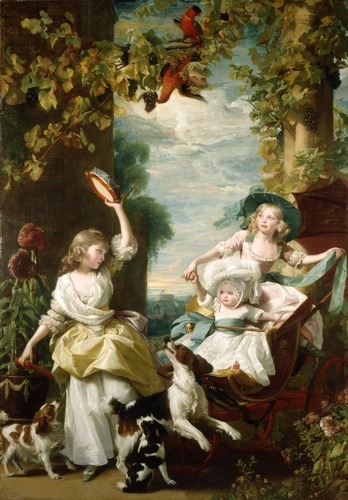
Everyone look, it’s Saera, Viserra and Gael!
#asoiaf#fire and blood#valyrianscrolls#saera targaryen#viserra targaryen#gael targaryen#saera messing around as usual#and gael looks so cute#saera and viserra are such chaotic icons and I love them#the painting is called the three youngest princesses#it's the three youngest daughters of george iii#though tbh i don't know if the ages match#I need to check the wiki
40 notes
·
View notes
Photo
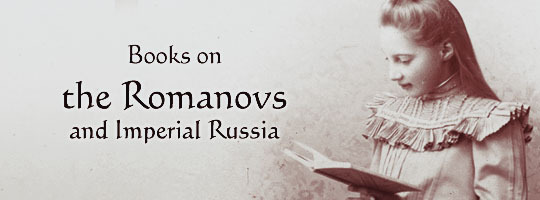
Here is a list of books you might want to read if you are interested in the Romanov dynasty and the country and society they goverened. I have read some, I own most and some may be of warying quality and reliability. Some include periods before and after the Russian Empire. Some could be fitted into more than one cathegory. A few are not available in English.I will try to update this list from time to time as I find new books or new books become published. Enjoy!
Diaries and correspondence of the Romanovs
The Memoirs of Catherine the Great
Love and Conquest: Personal Correspondence of Catherine the Great and Prince Grigory Potemkin
Chere Annette: Letters from St. Petersburg, 1820-1828: The Correspondence of the Empress Maria Feodorovna to Her Daughter the Grand Duchess Anna Pavlovna
A Lifelong Passion: Nicholas and Alexandra: Their Own Story
Romanov Family Yearbook: On This Date in Their Own Words
The Letters of Tsar Nicholas and Empress Marie
The Correspondence Of The Empress Alexandra Of Russia With Ernst Ludwig And Eleonore, Grand Duke And Duchess Of Hesse
The Complete Wartime Correspondence of Tsar Nicholas II and the Empress Alexandra: April 1914-March 1917
In the Steps of the Romanovs: Final Two Years of the Last Russian Imperial Family (1916-1918)
The Last Diary of Tsaritsa Alexandra
The Diary of Olga Romanov: Royal Witness to the Russian Revolution
Journal of a Russian Grand Duchess: Complete Annotated 1913 Diary of Olga Romanov, Eldest Daughter of the Last Tsar
Tatiana Romanov, Daughter of the Last Tsar: Diaries and Letters, 1913–1918
Maria Romanov: Third Daughter of the Last Tsar, Diaries and Letters, 1908–1918
1913 Diary of Grand Duchess Maria Nikolaevna: Complete Tercentennial Journal of the Third Daughter of the Last Tsar
Maria and Anastasia: The Youngest Romanov Grand Duchesses In Their Own Words
Correspondence of the Russian Grand Duchesses: Letters of the Daughters of the Last Tsar
Michael Romanov: Brother of the Last Tsar Diaries and Letters, 1916-1918
Diaries and correspondence of other people
Russian journal of Lady Londonderry, 1836-37
Letters from Russia
The Diaries of Sofia Tolstoy
Letters from St Petersburg: A Siamese Prince at the Court of the Last Tsar
The Romanovs Under House Arrest: From the 1917 Diary of a Palace Priest
Private Diary of Mathilde Kschessinska
A Countess in Limbo: Diaries in War & Revolution; Russia 1914-1920, France 1939-1947
Memoirs by the Romanovs
Once a Grand Duke
Always a Grand Duke
25 Chapters of My Life
Education of a Princess
A Princess in Exile
A Romanov Diary: The Autobiography of H.I.& R.H. Grand Duchess George
My life in Russia's service--then and now
Memories In The Marble Palace
Memoirs by other people
The Memoirs of Princess Dashkova
Lost Splendor
Memories of the Russian Court
My Mission to Russia and Other Diplomatic Memories
An Ambassador's Memoirs
The Real Tsaritsa
Thirteen Years at the Russian Court
The False Anastasia
Six Years at the Russian Court
Before the Storm
The Life and Tragedy of Alexandra Feodorovna Empress of Russia
Left Behind
At the Court of the Last Tsar
Memories of Russia 1916-1919
The Emperor Nicholas II: As I Knew Him
The Sokolov Investigation of the Alleged Murder of the Russian Imperial Family
The Russia That I Loved
Dancing in Petersburg: The Memoirs of Kschessinska
On the Estate: Memoirs of a Russian Lady before the Revolution
Theater Street
The Other Russia: The Experience of Exile
Russia Through Women's Eyes: Autobiographies from Tsarist Russia
The Fall of the Romanovs: Political Dreams and Personal Struggles in a Time of Revolution
Tommorow Will Come
Fanny Lear: Love and Scandal in Tsarist Russia
The Coronation of Tsar Nicholas II
Days of the Russian Revolution: Memoirs from the right, 1905-1917
The House by the Dvina: A Russian Childhood
Under Three Tsars
Last days at Tsarskoe Selo
Last Years of the Court at Tsarskoe Selo
The Real Romanovs
Biographies of the Romanovs and general topics concerning them
The Romanovs: Autocrats of All the Russias
The Romanovs: 1613-1918
The Romanovs
The Romanovs: Ruling Russia 1613-1917
Secret Lives of the Tsars: Three Centuries of Autocracy, Debauchery, Betrayal, Murder, and Madness from Romanov Russia
The Tragic Dynasty: A History of the Romanovs
The Family Romanov: Murder, Rebellion, and the Fall of Imperial Russia
Romanov Autumn: Stories from the Last Century of Imperial Russia
The Romanovs, 1818–1959: Alexander II of Russia and His Family
Alexis, Tsar of all the Russias
Sophia: Regent of Russia, 1657-1704
Peter the Great: His Life and World
Peter the Great
Terrible Tsarinas: Five Russian Women in Power
Elizabeth and Catherine: Empresses of All the Russias
Catherine the Great
Catherine the Great: Portrait of a Woman
Catherine the Great & Potemkin: the imperial love affair
Catherine the Great: Love, Sex, and Power
Great Catherine: The Life of Catherine the Great, Empress of Russia
The Empress of Art: Catherine the Great and the Transformation of Russia
Alexander I: The Tsar Who Defeated Napoleon
Alexander I: Tsar of War and Peace
Alexander of Russia: Napoleon's Conqueror
Nicholas I and Official Nationality in Russia 1825 - 1855
Nicholas I: Emperor and Autocrat of All the Russias
Becoming a Romanov. Grand Duchess Elena of Russia and her World
Alexander II: The Last Great Tsar
Katia: Wife Before God
Alexander III: His Life and Reign
Little Mother of Russia: A Biography of the Empress Marie Feodorovna
Nicholas II: Emperor of All the Russias
Nicholas II: Last of the Tsars
The Last of the Tsars : Nicholas II and the Russian Revolution
The Last Tsar: The Life and Death of Nicholas II
King, Kaiser, Tsar: Three Royal Cousins Who Led The World To War
A Gathered Radiance: The Life of Alexandra Romanov, Russia's Last Empress
The Last Empress: The Life and Times of Alexandra Feodorovna, Tsarina of Russia
Alexandra
Alexandra: The Last Tsarina
Nicholas and Alexandra
Alix and Nicky: The Passion of the Last Tsar and Tsarina
The Last Tsar & Tsarina
The Four Graces: Queen Victoria's Hessian Granddaughters
The Imperial Tea Party: Family, Politics and Betrayal: the Ill-Fated British and Russian Royal Alliance
From Splendor to Revolution: The Romanov Women, 1847-1928
Born to Rule: Five Reigning Consorts, Granddaughters of Queen Victoria
Queen Victoria and The Romanovs: Sixty Years of Mutual Distrust
Queen Victoria's Matchmaking: The Royal Marriages that Shaped Europe
Imperial Requiem: Four Royal Women and the Fall of the Age of Empires
The Romanov Royal Martyrs: What Silence Could Not Conceal
The Romanovs: Family of Faith and Charity
The Romanovs: The Final Chapter
The Last Days of the Romanovs: Tragedy at Ekaterinburg
The Fate of the Romanovs
The Murder of the Romanovs
The House of Special Purpose
The Murder of the Tsar
Alexei: Russia's Last Imperial Heir: A Chronicle of Tragedy
A Guarded Secret : Tsar Nicholas II, Tsarina Alexandra and Tsarevich Alexei's Hemophilia
The Romanov Sisters: The Lost Lives of the Daughters of Nicholas and Alexandra
The Grand Dukes
The Grand Dukes - Sons And Grandsons Of Russia's Tsars
The Other Grand Dukes: Sons and Grandsons of Russia's Grand Dukes
White Crow: The Life and Times of the Grand Duke Nicholas Mikhailovich Romanov, 1859-1919
The Grand Duchesses: Daughters & Granddaughters of Russia's Tsars
Once a Grand Duchess: Xenia, Sister of Nicholas II
Michael and Natasha: The Life and Love of Michael II, the Last of the Romanov Tsars
The Last Grand Duchess: Her Imperial Highness Grand Duchess Olga Alexandrovna
Olga Romanov: Russia's Last Grand Duchess
Ella: Princess, Saint and Martyr
Elizabeth, Grand Duchess of Russia
Grand Duchess Elizabeth of Russia: New Martyr of the Communist Yoke
Grand Duchess Marie Pavlovna
Princess Victoria Melita
A Fatal Passion: The Story of the Uncrowned Last Empress of Russia
Gilded Prism: The Konstantinovichi Grand Dukes & The Last Years Of The Romanov Dynasty
Death of a Romanov Prince
A Poet Among the Romanovs: Prince Vladimir Paley
Princesses on the Wards: Royal Women in Nursing through Wars and Revolutions
The Romanovs: The Way It Was
Behind the Veil at the Russian Court
The Flight of the Romanovs: A Family Saga
Russia and Europe: Dynastic Ties
Biographies of other people
The Tsar's Doctor: The Life and Times of Sir James Wylie
The Romanovs & Mr Gibbes: The Story of the Englishman Who Taught the Children of the Last Tsar
An Englishman in the Court of the Tsar: The Spiritual Journey of Charles Syndney Gibbes
The Forgotten Tutor: John Epps and the Romanovs
The Rasputin File
Rasputin: The Untold Story
Rasputin: Rascal Master
Rasputin: The Biography
Rasputin: a Short Life
The Murder of Grigorii Rasputin: A Conspiracy That Brought Down the Russian Empire
The Man Who Killed Rasputin: Prince Felix Youssoupov and the Murder That Helped Bring Down the Russian Empire
The Princess of Siberia
Angel of Vengeance: The Girl Who Shot the Governor of St. Petersburg and Sparked the Age of Assassination
Imperial Dancer: Mathilde Kschessinska and the Romanovs
Diaghilev: A Life
Nijinsky: A Life of Genius and Madness
The Russian Album
Russian Blood
Tolstoy: A Russian Life
The Pearl: A True Tale of Forbidden Love in Catherine the Great's Russia
Katya and the Prince of Siam
The Defiant Life of Vera Figner: Surviving the Russian Revolution
Pushkin: A Biography
Photoalbums, cofee-table books
The Camera and the Tsars: The Romanov Family in Photographs
The Romanov Family Album
Tsar: The Lost World of Nicholas and Alexandra
The Romanovs: Love, Power and Tragedy
The Regalia of the Russian Empire
The Sunset of the Romanov Dynasty
The Summer Palaces of the Romanovs: Treasures from Tsarskoye Selo
Royal Russia: The Private Albums of the Russian Imperial Family
Russia: Art, Royalty and the Romanovs
Nicholas II: The Last Tsar
Nicholas and Alexandra: The Family Albums
The Last Tsar
Romanovs Revisited
The Private World of the Last Tsar: In the Photographs and Notes of General Count Alexander Grabbe
The Jewel Album of Tsar Nicholas II: A Collection of Private Photographs of the Russian Imperial Family
Anastasia's Album
Lost Tales: Stories for the Tsar's Children
The Last Courts of Europe: Royal Family Album 1860-1914
Dear Ellen (Royal Europe Through the Photo Albums of Grand Duchess Helen Vladimirovna of Russia)
Royal Gatherings (Who is in the Picture? Volume 1: 1859-1914)
Jewels of the Tsars: The Romanovs and Imperial Russia
Jewels from Imperial St. Petersburg
Postcards from the Russian Revolution
Before the Revolution: A View of Russia Under the Last Czar
Twilight of the Romanovs: A Photographic Odyssey Across Imperial Russia
The Romanov Legacy: The Palaces of St. Petersburg
Moscow: Splendours of the Romanovs
Fabergé, Lost and Found: The Recently Discovered Jewelry Designs from the St. Petersburg Archives
Art of Fabergé
Faberge: Treasures of Imperial Russia
Artistic Luxury: Fabergé, Tiffany, Lalique
Russian Imperial Style
A Smolny Album: Glimpses into Life at the Imperial Educational Society of Noble Maidens
Konstantin Makovsky: The Tsar’s Painter in America and Paris
Anna Pavlova: Twentieth Century Ballerina
Tamara Karsavina: Diaghilev's Ballerina
General history and specific events
Russian Chronicles
Russia's First Civil War: The Time of Troubles and the Founding of the Romanov Dynasty
The Court of Russia in the Nineteenth Century; Volume 1
The Court of Russia in the Nineteenth Century; Volume 2
The Crimean War: A History
Internal Colonization: Russia's Imperial Experience
The Conquest of a Continent: Siberia and the Russians
Red Fortress: History and Illusion in the Kremlin
Sunlight at Midnight: St. Petersburg and the Rise of Modern Russia
St Petersburg: Three Centuries of Murderous Desire
The Shadow of the Winter Palace: Russia's Drift to Revolution 1825-1917
Society and lifestyle
Land of the Firebird: The Beauty of Old Russia
Serfdom, Society, and the Arts in Imperial Russia: The Pleasure and the Power
Lord and Peasant in Russia from the Ninth to the Nineteenth Century
A Bride for the Tsar: Bride-Shows and Marriage Politics in Early Modern Russia
Origins of the Russian Intelligentsia: The Eighteenth-Century Nobility
The Icon and the Axe: An Interpretive History of Russian Culture
The Court of the Last Tsar: Pomp, Power and Pageantry in the Reign of Nicholas II
Scenarios of Power: Myth and Ceremony in Russian Monarchy, Vol. 1
Scenarios of Power: Myth and Ceremony in Russian Monarchy, Vol. 2
Pavlovsk : The Life of a Russian Palace
Entertaining Tsarist Russia: Tales, Songs, Plays, Movies, Jokes, Ads, and Images from Russian Urban Life, 1779-1917
A Social History of the Russian Empire, 1650-1825
Slavophile Empire: Imperial Russia's Illiberal Path
Russia at Play
Women In Russian History: From The Tenth To The Twentieth Century
St. Petersburg: A Cultural History
Russian Peasant Women
Romanov Riches: Russian Writers and Artists Under the Tsars
The Magical Chorus: A History of Russian Culture from Tolstoy to Solzhenitsyn
Family in Imperial Russia
Village Life in Late Tsarist Russia
Imperial Crimea: Estates, Enchantments and the Last of the Romanovs
Russia on the Eve of Modernity: Popular Religion and Traditional Culture Under the Last Tsars
The Martha-Mary Convent: and Rule of St. Elizabeth the New Martyr
The Way of a Pilgrim
Icon and Devotion: Sacred Spaces in Imperial Russia
Natasha's Dance: A Cultural History of Russia
Valse Des Fleurs: A Day in St. Petersburg in 1868
Murder Most Russian: True Crime and Punishment in Late Imperial Russia
What Life Was Like in the Time of War and Peace: Imperial Russia, AD 1696-1917
When Miss Emmie Was in Russia: English Governesses Before, During and After the October Revolution
From Cradle to Crown: British Nannies and Governesses at the World's Royal Courts
What Became Peters Dream: Court Culture in the Reign of Nicholas II
Faberge's Eggs: The Extraordinary Story of the Masterpieces That Outlived an Empire
Beauty in Exile: The Artists, Models, and Nobility who Fled the Russian Revolution and Influenced the World of Fashion
Revolution and its general aftermath
Spies and Commissars: The Early Years of the Russian Revolution
A People's Tragedy: The Russian Revolution: 1891-1924
Interpreting the Russian Revolution: The Language and Symbols of 1917
The Russian Court at Sea: The Voyage of HMS Marlborough
Former People: The Final Days of the Russian Aristocracy
The Downfall of Russia
Doomsday 1917: The Destruction of Russia's Ruling Class
Caught in the Revolution: Petrograd, Russia, 1917
To Free the Romanovs: Royal Kinship and Betrayal in Europe 1917-1919
The Race to Save the Romanovs: The Truth Behind the Secret Plans to Rescue Russia's Imperial Family
Students, Love, Cheka and Death
Red Victory: A History of the Russian Civil War, 1918-1921
Conspirator: Lenin in Exile
Hidden Treasures of the Romanovs
Romanoff Gold: The Lost Fortunes of the Tsars
Russia Abroad: Prague and the Russian Diaspora, 1918–1938
Bread of Exile
The Many Deaths of Tsar Nicholas II: Relics, Remains and the Romanovs
Saving The Tsars' Palaces
Catalogues
Kejserinde Dagmar
Nicholas And Alexandra: The Last Tsar And Tsarina
Russian Splendor: Sumptuous Fashions of the Russian Court
At The Russian Court: Palace And Protocol In The 19th Century
History of Russian Costume from the Eleventh to the Twentieth Century
Collections of the Romanovs: European Arts from the State Hermitage Museum, St Petersburg
Magnificence of the Tsars: Ceremonial Men's Dress of the Russian Imperial Court, 1721-1917
Conspiracy and pretenders
Imperial Legend: The Mysterious Disappearance of Tsar Alexander I
The File on the Tsar
The Escape of Alexei, Son of Tsar Nicholas II: What Happened the Night the Romanov Family Was Executed
The Romanov Conspiracies
I am Anastasia; The Autobiography of the Grand Duchess of Russia.
The Resurrection of the Romanovs: Anastasia, Anna Anderson, and the World's Greatest Royal Mystery
A Romanov Fantasy: Life at the Court of Anna Anderson
The Secret Plot to Save the Tsar: The Truth Behind the Romanov Mystery
The Quest for Anastasia: Solving the Mystery of the Lost Romanovs
694 notes
·
View notes
Text
‘Prince George to play official role in the King’s Coronation: Second in line to the throne name as one of Charles III’s four Pages of Honour for May 6 ceremony
Prince George is to become the youngest future king to play an official role at a coronation, having been named one of his grandfather’s four Pages of Honour. T
he nine-year-old will be tasked with carrying the King’s robes alongside three other Pages of Honour - schoolboys Lord Oliver Cholmondeley, 13, Nicholas Barclay, 13, and Ralph Tollemache, 12. All three are the sons of His Majesty’s friends. Meanwhile, the Queen has chosen to include as her own Pages of Honour her three grandsons, twins Gus and Louis Lopes, 13, and Freddy Parker Bowles, 12, as well as her great-nephew, Arthur Elliot, 11.
All eight are expected to wear matching scarlet uniforms and will form part of the procession through the Nave of Westminster Abbey.
Pages of Honour traditionally wear a knee-length scarlet coat with gold trimmings over a white satin waistcoat and lace jabot - a decorative ruffle or frill falling from the collar - white breeches, white stockings and black shoes with buckles. They also carry a small ceremonial sword.
The May 6 ceremony will mark the biggest moment on the world stage for Prince George, second in line to the throne and the youngest of the eight Pages.
His parents, the Prince and Princess of Wales, are understood to have thought long and hard about whether to allow him to take on an official role, owing to his tender years. It is thought that they made their decision after discussing it with him in detail to ensure he was comfortable with carrying out such a public duty.
His siblings - Princess Charlotte, seven, and four-year-old Prince Louis, who turns five later this month - are expected to attend the Coronation but sit among the congregation. Prince George is thought likely to join them for the service.
The decision to give the Queen’s family such high-profile roles is said to represent a new era of equality behind palace walls, reflecting the King’s devotion to his wife and the realities of the modern blended family. It is thought that her granddaughters, Lola and Eliza, may also play a role in the ceremony, although further details have not yet been announced.
Palace sources noted that pages are traditionally boys and so only grandsons of a suitable age could be chosen.
Lord Cholmondeley is the second son of the Marquess of Cholmondeley, the King’s Lord-in-Waiting, and his wife the Marchioness of Cholmondeley, former model Rose Hanbury. The couple also have a son, Alexander, Earl of Rocksavage, Lord Cholmondeley’s twin brother, and daughter, Lady Iris, seven. It is understood that Lord Cholmondeley was chosen for the Coronation role in recognition of the fact that his twin is set to inherit their father's title. The family live at Houghton Hall in Norfolk, which is just four miles from Anmer Hall, the Prince and Princess of Wales’s country retreat. The foursome are good friends.
Nicholas Barclay is the grandson of Sarah Troughton, one of the Queen’s Companions and the Lord Lieutenant of Wiltshire. The Colman’s Mustard heir is a second cousin of the King and a former lady-in-waiting to the Duchess of Kent. Her daughter, Rose - Nicholas's mother - is one of the King’s 32 godchildren.
Ralph Tollemache is the elder son of banker Edward Tollemache, also one of the King’s godchildren, who was a Page of Honour to the late Queen from 1988 to 1990. His younger brother, James, was friends with the Prince of Wales at Eton. They are the sons of brewery heir John Tollemache, 5th Baron Tollemache, and his garden designer wife Alexandra Meynell.
While Prince George will be the only one of his three siblings with an official role, all three are expected to take part in the Coronation procession from Westminster Abbey back to Buckingham Palace. Plans show that George, Charlotte and Louis will all join their grandfather and the Queen as they leave the Abbey following the ceremony. They will then likely appear together on the palace balcony.
At the past two coronations, young heirs have remained in the congregation. In 1937, Princess Elizabeth, aged just 11, watched as her father, George VI, was crowned. At Elizabeth II’s own ceremony in 1953, Charles, aged four, sat next to his grandmother Queen Elizabeth the Queen Mother.’
via The Telegraph
6 notes
·
View notes